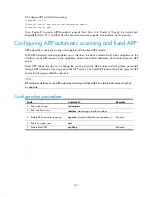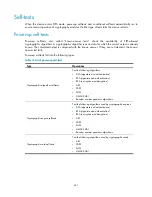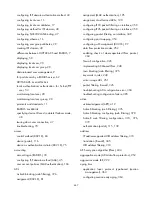
438
{
If both a default route and the
allow-default-route
keyword are configured, URPF's decision
depends on the check approach. In strict approach, URPF lets the packet pass if the outgoing
interface of the default route is the receiving interface. Otherwise, URPF rejects it. In loose
approach, URPF lets the packet pass directly.
4.
A rejected packet is filtered by an ACL, if specified. If the packet is permitted by the ACL, it is
forwarded as normal (such packets are displayed in the URPF information as "suppressed drops"
by using
display ip interface
). Otherwise, it is discarded.
Configuration procedure
configure URPF on a specific interface. URPF configured on an interface takes effect on the interface
only.
To do...
Command…
Remarks
1.
Enter system view.
system-view
––
2.
Enter interface view.
interface
interface-type interface-
number
––
3.
Enable URPF check on the
interface.
ip urpf
{
loose
|
strict
} [
allow-
default-route
] [
acl
acl-number
]
Required
Disabled by default
NOTE:
•
URPF only checks packets arriving at the interface.
•
After configuring the URPF check on an interface, use
display ip interface
to view statistics of packets
discarded by URPF (displayed as "Drops") and "Suppressed drops." If you configure the URPF check
globally, no statistics are displayed.
URPF configuration examples
Network requirements
As shown in
, a client (Router A) directly connects to the ISP router (Router B). Enable strict
URPF check on GigabitEthernet1/0/1 of Router B to allow packets whose source addresses match ACL
2010 to pass. Enable strict URPF check on GigabitEthernet1/0/1 of Router A to allow use of the default
route for URPF check.
Figure 154
Network diagram for URPF configuration example
















































